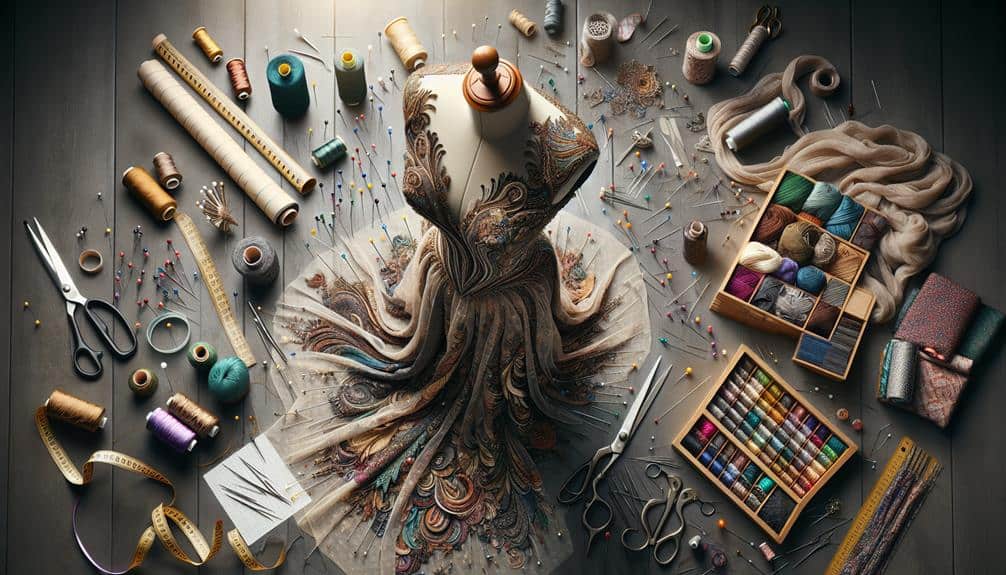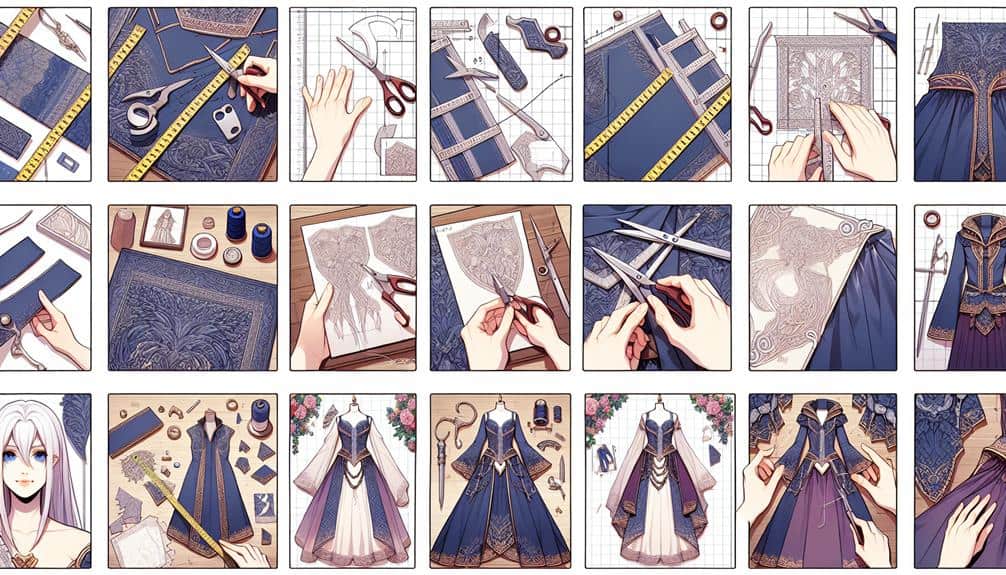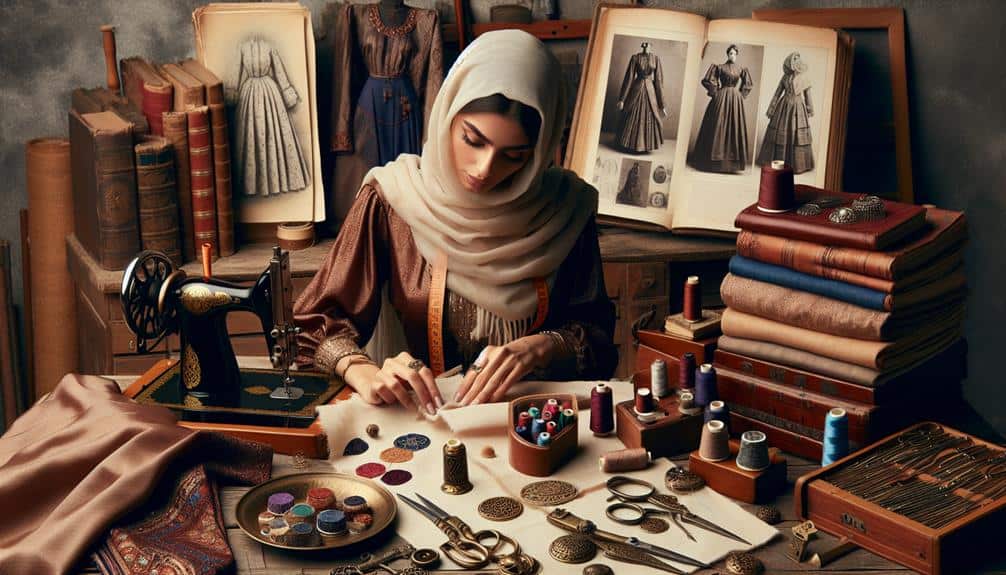Ever wondered how intricate and elaborate costumes are meticulously crafted?
The art of tailoring detailed costumes involves a series of precise steps that transform fabric into stunning attire.
From selecting the perfect material to adding the final embellishments, each stage contributes to the creation of a one-of-a-kind masterpiece.
But what exactly goes into each step?
The secrets behind bringing these intricate designs to life lie in the careful execution of techniques that will elevate your costume-making skills to a whole new level.
Key Takeaways
- Choose fabrics and colors thoughtfully to enhance costume details.
- Ensure precise measurements and pattern drafting for a perfect fit.
- Utilize varied sewing techniques and embellishments for character accuracy.
- Pay attention to texture, color, and embellishments for a professional costume finish.
Choosing the Right Fabric
When selecting fabric for your detailed costume, consider the texture and drape to make sure it complements the intricate design. The fabric selection is important as it can make or break the overall look of your costume. Opt for fabrics that not only match the color coordination of your design but also enhance its details. For instance, if your costume features delicate embroidery, choose a fabric that will showcase this intricate work effectively.
Color coordination plays a significant role in fabric selection. Make sure that the colors of the fabric you choose align with the color scheme of your costume design. If your costume is vibrant and colorful, you may want to pick a fabric that allows the colors to pop. On the contrary, if your design is more subdued, selecting a fabric with a softer color palette might be more suitable.
Taking Accurate Measurements
For the most precise fit of your detailed costume, start by meticulously capturing your measurements to make sure every aspect of the design aligns perfectly with your unique shape and size. To achieve this, follow these measuring techniques for accurate results:
- Bust: Wrap the measuring tape around the fullest part of your bust, making sure it's parallel to the ground for an accurate measurement.
- Waist: Locate the natural waistline, typically the smallest part of the torso, and measure around it while keeping the tape comfortably snug.
- Hips: Measure around the fullest part of your hips, making sure the tape is parallel to the floor and not too tight to allow for movement.
- Inseam: For pants or trousers, measure from the crotch down to the desired length, usually where you want the garment to end.
Consider size variations and take into account any fluctuations in your measurements to make sure a well-fitted and comfortable costume tailored specifically to your unique dimensions.
Designing the Pattern
To create a detailed costume that fits you perfectly, begin by drafting a precise pattern tailored to your measurements and design vision. Pattern drafting is like creating a blueprint for your costume, guaranteeing every piece comes together seamlessly.
Start by transferring your measurements onto pattern paper, marking key points like bust, waist, and hips. Use rulers and curves to connect these points, shaping the pattern according to your design. Make fitting adjustments by comparing the drafted pattern to your measurements and making changes as needed. This step is essential to achieve a costume that fits comfortably and looks stunning.
Pay attention to details like seam allowances and darts to guarantee a professional finish. Once you're satisfied with the pattern, you're ready to move on to the next exciting step of sewing and assembling your intricate costume. By taking the time to design a precise pattern, you're one step closer to bringing your costume vision to life.
Sewing and Assembling the Costume
Begin your journey into creating a stunning costume by meticulously sewing and assembling each intricate piece with care and precision.
- Fabric Selection: Choose fabrics that not only match the character but also complement each other in color coordination. Imagine the softness of silk flowing gracefully or the structure of a sturdy cotton providing the perfect foundation for your creation.
- Stitching Techniques: Utilize various stitching techniques to bring your costume to life. From delicate hand-stitching for fine details to precise machine stitching for durability, each stitch plays a vital role in the overall look and feel of the costume.
- Color Coordination: Pay attention to how different colors interact with each other. Consider the mood and personality of the character you're portraying when selecting the color palette for your costume.
- Finishing Touches: Add final embellishments like buttons, zippers, or snaps to give your costume a polished look. These small details can elevate your creation from good to exceptional.
Adding Detailed Embellishments
Enhance the intricate beauty of your costume by skillfully incorporating detailed embellishments that capture the essence of your character's persona. When adding embellishments, consider utilizing various beading techniques and embroidery styles to bring your costume to life. Beads can add a touch of elegance and sparkle, while embroidery can create intricate patterns and designs that showcase your attention to detail.
Incorporating color theory is important when selecting embellishments. Choose colors that complement your costume's palette to create a harmonious look. Additionally, experiment with texture contrast by mixing different fabrics and materials for a visually appealing effect. Combining smooth and textured elements can add depth and dimension to your costume.
Frequently Asked Questions
How Can I Make Sure My Costume Is Comfortable to Wear for Long Periods of Time?
To guarantee your costume is comfy for eternity, choose breathable materials like cotton. Opt for fittings that enhance mobility. Remember, a costume that feels like a cloud on a sunny day is the holy grail!
What Is the Best Way to Store My Detailed Costume When It Is Not in Use?
When not in use, store your detailed costume properly to maintain its quality. Use preservation techniques like hanging it in a garment bag or laying it flat in a cool, dry place. Protect your hard work!
How Do I Ensure That My Costume Is Durable and Long-Lasting?
To make sure your costume lasts, prioritize preservation by storing in a cool, dry place. Repair any tears promptly. Choose sturdy fabrics and reinforce seams. Regularly inspect for wear and tear. Remember, proper care adds years to the costume's life.
Are There Any Special Techniques for Cleaning and Maintaining a Detailed Costume?
To preserve a detailed costume, use gentle washing techniques for stain removal. Avoid harsh chemicals that could damage the fabric. When handling, be mindful of delicate embellishments. Proper care guarantees your costume stays vibrant and long-lasting.
What Should I Do if I Make a Mistake While Sewing or Assembling My Costume?
When mistakes occur while sewing your costume, fear not! Troubleshooting mistakes is part of the crafting journey. Look for quick fixes like seam ripping, hand stitching, or adding embellishments to cover errors. Keep calm and sew on!


